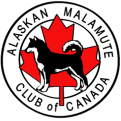Breed Characteristics
The Alaskan Malamute was named after the native Inuit tribe called Mahlemuts who settled along the shores of Kotzebue Sound in the upper western regions of Alaska and is the largest sledge dog native to North America. Unlike its "racing cousin's", the Malamute is specifically built for heavy freighting. His strength and endurance is second to none.
APPEARANCE
Though you will see Malamutes smaller and some larger, the ideal freighting size is 23"/75 lbs for females and 25"/85 lbs for males. Their double coats are thick and course, enabling them to withstand severely cold temperatures. The oily, water repellent texture needs little maintenance except when shedding, when the undercoat must be removed to promote healthy skin. Malamutes can tolerate most climates, though extra care is necessary to keep them comfortable in hot weather. They come in a variety of colours, the most common being grey and white and black (seal) and white. Distinctive and varied facial markings make each a unique specimen.
BEHAVIOUR
Malamutes are self-confident, strong-willed, independent thinkers, intelligent and affectionate friendly dogs, unsuitable for guard work, although their size and appearance alone will usually discourage intruders. They are happiest as outdoor dogs, given sufficient companionship, but many thrive as house pets. They demand attention, and failing to receive enough, will become nuisances, howling like wolves and digging holes that would put any backhoe to shame. Malamutes are patient with children, but like all large dogs, should be supervised during play. For athletic people, Malamutes are ideal. They love backpacking, hiking and sledding. They can do well in obedience even though their great joy in life is to entertain the audience with a series of comedy antics.
TRAINING
The Malamute is a large pack oriented animal with the natural instinct to lead or be lead; therefore training and obedience lessons must begin at a very early age. This breed cannot be allowed to grow up lacking controlled socialization with humans and animals as they can become dominating over people they don't respect and quite aggressive with other dogs of their same sex.
Though you will see Malamutes smaller and some larger, the ideal freighting size is 23"/75 lbs for females and 25"/85 lbs for males. Their double coats are thick and course, enabling them to withstand severely cold temperatures. The oily, water repellent texture needs little maintenance except when shedding, when the undercoat must be removed to promote healthy skin. Malamutes can tolerate most climates, though extra care is necessary to keep them comfortable in hot weather. They come in a variety of colours, the most common being grey and white and black (seal) and white. Distinctive and varied facial markings make each a unique specimen.
BEHAVIOUR
Malamutes are self-confident, strong-willed, independent thinkers, intelligent and affectionate friendly dogs, unsuitable for guard work, although their size and appearance alone will usually discourage intruders. They are happiest as outdoor dogs, given sufficient companionship, but many thrive as house pets. They demand attention, and failing to receive enough, will become nuisances, howling like wolves and digging holes that would put any backhoe to shame. Malamutes are patient with children, but like all large dogs, should be supervised during play. For athletic people, Malamutes are ideal. They love backpacking, hiking and sledding. They can do well in obedience even though their great joy in life is to entertain the audience with a series of comedy antics.
TRAINING
The Malamute is a large pack oriented animal with the natural instinct to lead or be lead; therefore training and obedience lessons must begin at a very early age. This breed cannot be allowed to grow up lacking controlled socialization with humans and animals as they can become dominating over people they don't respect and quite aggressive with other dogs of their same sex.
Malamute Colours
Black and White - Born almost entirely black. No gray undercoat.
Seal and White - Look 'black and white' but have gray undercoat.
Gray and White - The most common color. Light to dark gray.
Sable - Gray or black but with 'red' throughout the coat.
Red and White - Red top coat of light (almost rose) and deep red shades.
White - Might be very white, cream, buff or have a tinge of pink.
Seal and White - Look 'black and white' but have gray undercoat.
Gray and White - The most common color. Light to dark gray.
Sable - Gray or black but with 'red' throughout the coat.
Red and White - Red top coat of light (almost rose) and deep red shades.
White - Might be very white, cream, buff or have a tinge of pink.
